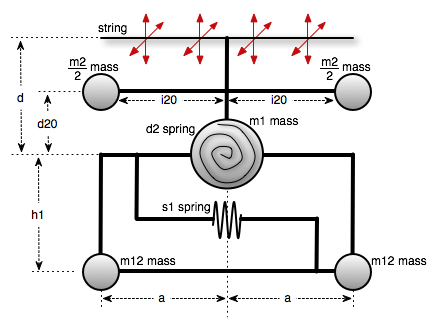Cello Bridge
Description
A basic cello bridge model.

(make-object 'cello-bridge ... )
Lisp Syntax and Default Values
A 'cello-bridge can be created using the following Lisp syntax (the default values are shown for each of the physical parameters):
(make-object 'cello-bridge
(m1-mass .0046)
(m2-mass .0059)
(m12-mass .0024)
(d-distance .032)
(d20-distance .011)
(h1-distance .052)
(a-distance .035)
(i20-distance .026)
(d2-stiffness 716.8)
(s1-stiffness 360000)
(freq-loss 10)
(const-loss 10))
Parameters
All physical parameters can be numerical values or controllers.
- m1-mass: central mass of the bridge in kg
- m2-mass: masses at the upper part of the bridge in kg
- m12-mass: masses at the base/feet of the bridge in kg
- d-distance: distance from the string to the central mass in meters
- d20-distance: distance from the central mass to the upper mass in meters
- h1-distance: distance from the central mass to the feet in meters
- a-distance: distance from the center to the edge of the bridge (i.e. half the total bridge width) in meters
- i20-distance: distance from the center to the upper masses on either side of the bridge in meters
- d2-stiffness: stiffness of the central mass spring
- s1-stiffness: stiffness from the central mass to the feet
- freq-loss, const-loss: loss coefficients. See General object information.
Accesses
To access the feet of a cello bridge (to adhere it to an instrument body, or make an output on it, for example), the special access type 'base is used. -1 refers to the left foot, and 1 refers to the right. (A number in-between will specify an access somewhere in the middle.)
(make-access my-cello-bridge (const -1) 'base) ;;; left foot
(make-access my-cello-bridge (const 1) 'base) ;;; right foot
(make-access my-cello-bridge (const distance) 'top-horizontal)
(make-access my-cello-bridge (const distance) 'top-vertical)
Options
There are no special options for the Cello Bridge